|
|
The system which was not accepted by the cine amateur
I. Introduction
We would like to describe the history of the filming system, which was applied for a short time in the home movie equipment.
In 1955 was introduced a new camera, French manufactured, Pathé Lido 9,5 mm. In France it was available in several versions;
- Lido I, or Classic, for standard 9,5 mm film;
- Lido Duplex, which takes the special double perforated 9,5 mm film;
- Lido IV, or Universal, which can take both types of film and is also equipped with variable speeds.
The list of the Lido 9,5 mm variation was published in the ACW, in 1958. However in August 15, 1963 was published a new Test review of just newcomer camera from France the Lido IV 9,5 mm, with reduced price, one year earlier, in 1962.
In the review we are reading that it is Lido IV Classic. This model has shutter release button with 4 positions – safety locking, time exposure, frame by frame, continuous filming; and provision for Bowden cable filming. It takes only standard 9,5 mm film. Introduced model has 4 speeds – 8, 16, 24, 32 fps. This model has a description, below words “Lido” is word– Classic. This model is in our collection.
 
Pict 1; Lido IV classic in our collection; ©Anna Vacani
In the Pathé catalogue, French edition, was introduced another Lido 9,5 mm camera, with description on the side “Pathé De duplex”.
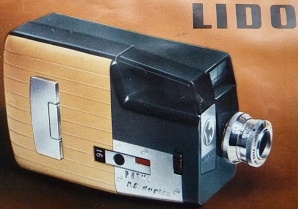
Pict 2; Lido 9,5 mm camera; Photo courtesy of “Pathé” catalogue - French edition (in our collection)
The same catalogue announced conversion of National III into Duplex system.
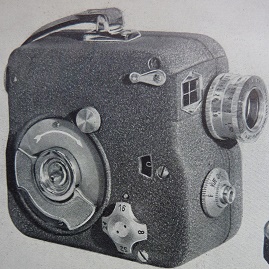
Pict 3; National III Duplex 9,5 mm camera; Photo courtesy of “Pathé” catalogue - French edition (in our collection)
A camera was advertised in ACW September 1956, as “The 9,5 mm HDM Cine Camera. This attractive newcomer to the Duplex Range is an adapted version of the already famous Pathescope H camera. The HDM [...] and is charger loaded with 25 ft of Duplex film (colour or black and white) converted to 50 ft of sensational Widescreen film”
Additionally, the Lido camera was produced in 16 mm and 8 mm. The 8 mm model is accepting Double 8 film.

Pict 4; Lido 16 mm camera; Photo courtesy of “Movie Guide 1958-59 Pathé” -Australian edition (in our collection)
Pathé produced spool films and chargers with Duplex system.
We would like to discuss, and find out why the model was not popular among amateur cinema users and what happened with the cameras already produced.
II. The system announced in 1955 and the new features
In the Pathé “General catalogue 1957” (in our collection) the Pathé announced: “ S.C.I. PATHE has very much pleasure in offering amateur cinematographers the Wide Screen by means of a new PATHE 9,5 mm DUPLEX – which brings him an irresistible and sensational advantage – that of economy (of film and money) up to 50% for black and white and for colour. This 100% French innovation makes the PATHE 9.5 mm DUPLEX process the formula for the future, which opens infinite prospect for the cine amateur”.
Let’s look how the DUPLEX system is designed.
The system is presented in the catalogue, in the form of drawings:

Pict 5; Photo courtesy of Pathé “General catalogue 1957”
The 9,5 mm film, in DUPLEX system, has two neighbouring perforation instead of one only in the classic film.
Next new feature gives possibility of filming either vertically or horizontally. In the camera is a special mask control button which should be placed – either on the mark “full picture” for films in DUPLEX (full picture) or on the mark “half picture” for films in Monoplex (half picture).
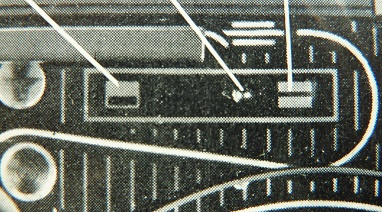
Pict 6; Pict, from the Instruction book “Pathé camera 9,5 mm Lido” – the left arrow pointed to the indicator “half picture”; the middle arrow is pointed to the control button; the right arrow is pointed to the “full picture”.
Vertically filming (full width) with DUPLEX gives the same picture area as that of 9,5 mm Classic. The horizontally filming, with DUPLEX, enables the recording of a widescreen picture occupying half the width of the film. It gives a widescreen effect, with a screen ratio 1.6 to 1. This format is known as Monoplex:

Pict 7; Photo courtesy of Pathé “General catalogue 1957”
By reversing the charger of the film in the camera, you expose the second half of the DUPLEX film, which in consequence is composed of two bands of coupled images for wide screen.
Reading further in the Pathé catalogue: “After processing, the film is cut into two lengthwise on special high precision machines and the two bands joined end to end. They are than to be used on a DUPLEX projector (possessing a horizontal movement), which will project on the screen an image picture in the proportion of 1, 6 x 1 (instead of 1, 33 x 1 of the Classic formula).”
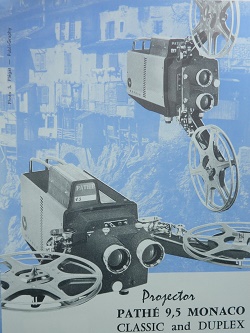
Pict 8; Pathé 9,5 mm projector Classic and Duplex; Photo courtesy of Pathé “General catalogue 1957”
The projector was fitted with special adjustments; the chosen film gate is moved into position by rotation of the turret head, it is visible in the above picture. It was fitted with 40 mm lens for Duplex or classic projection and 30 mm lens for Monoplex.
The projector and Lido Duplex camera were advertised in ACW May 1956 edition. It was announced:”Introducing the Superb New Pathé DUPLEX widescreen 9,5 mm ‘Lido’ camera.... and its partner the Pathé 9,5 mm ‘Monaco’ Projector”.
It should be say that in the Pathé catalogue, French edition, was advertised the Marignan 9,5 mm projector and was added information, that the mentioned projector can be transformed into Duplex system.
III. New Lido cameras
Presumably the first cameras were produced in 1955. We are reading in ACW February 1956, page 1056; “Now that Duplex is here, be wondering whether to have their cameras and projectors modified to take the new film. But there is no need to go to that expense if you want to give Monoplex filming [further is an advise how to use a normal camera and projector to achieve the same effect]”.
The Lido camera is the only one to have received a Gold Medal for design, at the Milan Triennale, in 1956.
Construction and finish
The camera was originally designed for Classic-Monoplex-Duplex system. For the Monoplex double run the camera was held on its side – horizontally. In this way the shape of the top and bottom of the camera was profiled for the better hold in horizontal position.
The body is built of aluminium alloy die-castings, with all fittings chrome plated. It is finished in smooth silver-gray enamel and the door is finished completely in matt black.
A metal loop attaches the lid to the carrying strap which is similarly fastened to the camera body.
A continental type tripod bush is fitted at the very front of the camera base. Our camera has the English to Continental adaptor.
Optical system
The camera is fitted with type “C” mount to take a range of lenses. Our camera is fitted with lens SOM Cinor B, Berthiot, No H57626; f2,5 fixed, focusing 20 mm.
As we are reading in the instruction book; “The 2,5 lens of F=20 mm does not have any focussing adjustments – lens set on 19 ½ feet, and all the pictures taken from 10 feet to infinity give a sharp picture on the film.”
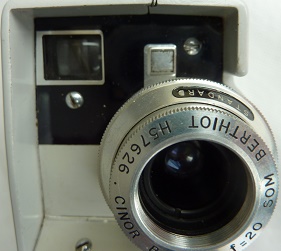
Pict 9; The lens & viewfinder window & Format indicator (full picture or half picture); ©Anna Vacani
Next to viewfinder window is fitted Format indicator which in the Duplex system indicated which format of the film is in use.
The viewfinder is fitted with a few adjustments. The front element of the viewfinder is engraved to show the field of a 50 mm telephoto lens. Behind this front element is another supplementary lens which may be brought into place by turning a small knob, just in front of the name plate. This lens enlarges the field seen to that covered by a 10 mm lens adapter.
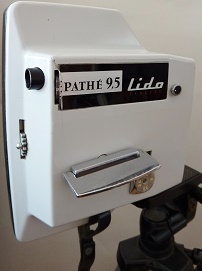
Pict 10; Control knob for the viewfinder (at the Lido word) & viewfinder & opening and closing latch (below of the viewfinder); ©Anna Vacani
External features
Looking at the camera side, we can find other features
- Winding key
- Metric counter
- Speeds (only on some models)
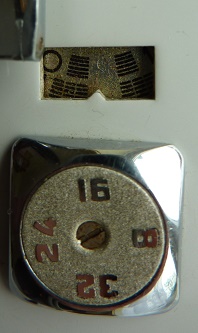
Pict 11; Metric counter & Speeds; ©Anna Vacani
- And control knob for the viewfinder
In front of the camera, there are visible other control elements:
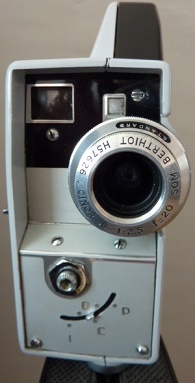
Pict 12; Lido 9,5 mm camera; front; ©Anna Vacani
- Starting button; this release button is threaded to take a standard cable release and in addition the end of the button is knurled. When it is depressed, a slide turn clockwise, easy because of the knurling, locks the release for continuous run.
- Positions for filming:
I – single pictures shutter speed according to camera speed setting
O - Two positions of safety lock
C – Continuous run
P -Single pictures shutter open.
- Viewfinder glass
- Format indicator (full picture or half picture).
Type of loading and transit mechanism
The version Lido I or Classic it is a camera for standard 9,5 mm film. It takes 50 ft reels. As it was described other version of the Duplex cameras, some of them takes the chargers 25 ft – named HB.
The protective band, fitted in the chamber surrounds spools, prevents light fogging the film.
In the camera chamber is the printing on the base plate showing the film path for loading.
The gate opens only far enough to allow the film to be dropped through.

Pict 13; Lido 9,5 mm camera threading path; front; ©Anna Vacani
The gate is opened and closed for loading by a sliding control button situated near the rear of the spool chamber (in the picture at the bottom edge). Opening the gate automatically reset the footage counter to its starting position – to zero.
Using the 9,5 Duplex film – 2 central perforation the central sprocket has to be lift upwards as far as the stop.
Thread the film along the course marked on the plate of the camera, making sure that the sprocket teeth fit well into the perforation and making a loop as shown on the marking (smaller one). Lock the presser by sliding the control button. Press the starting button a few times to check the satisfactory working.
Production number of our camera: 00312.
IV Why it was not popular
The camera was advertised around the world.
We can explain this issue in one short sentence – The system was too complicated and addressed to only one article of the Pathé – Lido camera.
Why it was too complicated?
- You can use the Monoplex system by reversing the charger of the film in the camera or on spool camera you turn the film over at the end of the first run; you expose the second half of the DUPLEX film, which in consequence is composed of two bands of coupled images for wide screen.
- The adjustment of the camera before filming is complicated and confusing users of the camera – adjustment of the sprocket and the control button for the indicator “half picture” or “full picture”.
- The processing of the film requires suitable devices. The processing station had to buy that special equipment to split the film. It was two stations, at that time – one in Paris and second in London which provided this service.
- The film projection requires a special DUPLEX projector - Monaco, which can project the film in horizontal position. Additionally, the projector has to be properly set for Duplex mode. When it is not done with the instruction book, it is easy to permanently damage it.
Next problem it is the spool size- 4.75 mm for the Monoplex system, when the film was split into half size.
Than to project the film you have to adjust the lenses on the projector and position of the projector (Pict 8).
Pict 14; Preparing the projector Monaco; Picture courtesy of Pathé Projector 9,5 mm Monaco for 9,5 mm films Classic – Duplex – Monoplex, Instruction Book
V. What happened with the cameras already produced
The Pathé Company was expected that it will be very popular system and produced a lot of cameras. The system and products were very strongly advertised around the world. Many catalogues were published. It cost a lot of money.
The Monoplex system was discontinued, by Pathé.
When the market was not interested in this complicated system, the Pathé decided to adapt the already produced cameras to Classic 9,5 mm system.
The adjustment, which was applied, we can see in our camera.
- The first adjustment it was removed the control button which should be placed – either on the mark “full picture” for films in DUPLEX (full picture) or on the mark “half picture” for films in Monoplex (half picture).
 
Pict 15; The marks in the camera – without the control button and with control button in Duplex system; ©Anna Vacani
- Next adjustment we can notice in above pictures. The film loop was shortened, because the protective band that was fitted in the chamber. It was surrounding the spools, to stop the scratching of the film with the longer original film loops, the film was touching the bands.
- The sprocket is fixed permanently to classic 9,5 mm film.
- The Format indicator (by the viewfinder window) for full picture or half picture is permanently covered.
VI. Summarizing
We are under impression that, at the beginning, the Pathé Company tried to prolong life of the 9,5 mm format. Pathé took the effort to attract the cine amateur customers to this new idea Classic/Duplex/Monoplex system 9 mm.
However, at that time the other formats – 8 mm and 16 mm were very well placed in the market. In this way the 8 & 16 mm Lido cameras were released into the market.
Literature;
This article was written based on our experiences and on the following sources (in our collection);
- Pathé Camera 9,5 mm Lido Universal – Duplex – Classic Instruction for use;
- Pathé “General catalogue 1957”;
- “Movie Guide 1958-59 Pathé” -Australian edition;
- Pathé catalogue, French edition;
- ACW published – February 1956; May 1956; September 1956; 1958; August 15, 1963;
- Pathé Projector 9,5 mm Monaco for 9,5 mm films Classic – Duplex – Monoplex, Instruction Book (in English and in French languages – in our collection).
|
|

